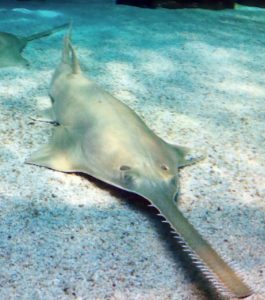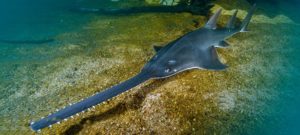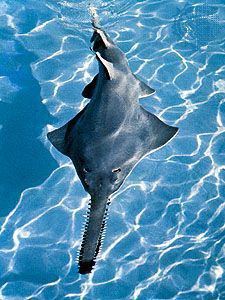
The Sawfish, also known as the Carpenter Fish, is a fascinating and enigmatic creature, named for the large, saw-like structure protruding from its snout. This intriguing adaptation is a testament to the wonders of nature and its incredible diversity.
The Saw: A Weapon and a Sensory Tool:
The sawfish’s rostrum, the technical term for its saw-like extension, is an incredibly powerful and versatile tool.
• Cutting Power: The saw is lined with sharp teeth arranged in a transverse pattern, resembling a saw blade. The sawfish uses this structure in a back-and-forth motion to stun or cut its prey, often slicing fish in half with remarkable precision.
• Digging and Foraging: The saw can also be used to dig through sediment, unearthing prey buried in the sand or mud.
• Sensory Sensation: The saw is not just a weapon, but also a sophisticated sensory organ. The rostrum is densely packed with electroreceptors, which detect the tiny electrical signals given off by living creatures in the water.
Hunting in Darkness and Murky Waters:
The sawfish’s electroreceptors make it a master of hunting in low light conditions or murky water. They can pinpoint the location of their prey even when visibility is limited, allowing them to hunt effectively at night or in areas where visibility is obscured.
A Majestic, Yet Endangered, Creature:
Sawfish are among the largest rays, reaching impressive lengths of up to 7-7.6 meters (23-25 feet). They are found worldwide in tropical and subtropical coastal waters, estuaries, and even freshwater rivers and lakes.
Facing a Dire Threat:
Despite their majestic size and unique adaptations, sawfish are facing an alarming decline in populations. Their saw, while an impressive tool for hunting, is also unfortunately targeted by fishermen who mistakenly believe it has medicinal value. Habitat loss, pollution, and fishing pressure further contribute to their vulnerability. All species of sawfish are now classified as endangered, highlighting the critical need for conservation efforts.
Protecting the Sawfish:
Protecting this remarkable creature requires a multi-pronged approach:
• Education and Awareness: Raising awareness about the importance of sawfish and the consequences of their decline is crucial for shifting perceptions and encouraging responsible fishing practices.
• Habitat Protection: Protecting their critical habitats in coastal and freshwater areas is essential for their survival.
• Regulation and Enforcement: Stricter regulations and enforcement measures are needed to limit fishing and prevent the illegal trade in sawfish.
The sawfish, with its unique adaptations and remarkable hunting abilities, is a testament to the fascinating diversity of the natural world. It’s our responsibility to ensure that this iconic creature has a future, as its survival is a reflection of the health and resilience of our planet’s ecosystems.

Summary on Saw fish-Carpenter Fish
It gets this name from the large ‘saw’ attached to the front of its body that resembles a saw. This saw is called a rostrum
The saw can be used in a back-and-forth swiping motion to cut prey in half or to dig through the sediment
sawfish’s rostrum is filled with sensory organs,These sensory organs help the sawfish detect tiny electrical signals given off by their prey. This helps them hunt at night and in murky water
Sawfish, also known as carpenter sharks, are a family of rays characterized by a long, narrow, flattened rostrum, or nose extension, lined with sharp transverse teeth, arranged in a way that resembles a saw. They are among the largest fish, with some species reaching lengths of about 7–7.6 m .
Habitat= They are found worldwide in tropical and subtropical regions in coastal marine and brackish estuarine waters, as well as freshwater rivers and lakes. All species are endangered.

 Pazionmedia.com Pazion Media l Latest News l Politics l Sports l Entertainment
Pazionmedia.com Pazion Media l Latest News l Politics l Sports l Entertainment



